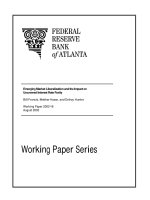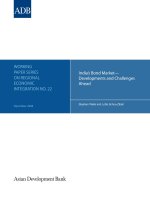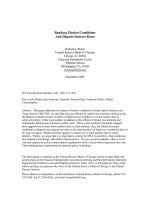R20 market indexes and benchmarks
Bạn đang xem bản rút gọn của tài liệu. Xem và tải ngay bản đầy đủ của tài liệu tại đây (355.36 KB, 20 trang )
Level III
Reading 20
Market Indexes and Benchmarks
www.irfanullah.co
Graphs, charts, tables, examples, and figures are copyright 2014, CFA Institute. Reproduced
and republished with permission from CFA Institute. All rights reserved.
Overview and Introduction
1. Introduction
2. Distinguishing between a Benchmark and a Market Index
3. Benchmark Uses and Types
4. Market Indexes Uses and Construction
5. Index Weighting Schemes: Advantages and Disadvantages
6. Benchmark Selection: An Example
www.irfanullah.co
2
2. Distinguishing between a Benchmark and a Market Index
Benchmark
Market Index
Oxford Dictionary: “a standard or point of reference
against which things may be compared”
A market index represents the performance of a
specified security market, market segment, or asset
class
A standard or point of reference for evaluating the
performance of an investment portfolio
Can be used as a benchmark
Market indexes have a wide variety of uses
Benchmark should be specific to a particular
manager’s investment process
Unambiguous, investable, measurable, appropriate,
reflective of current investment opinions, specified in
advance, and accountable (“owned”)
www.irfanullah.co
3
3. Benchmark Uses and Types
Users of benchmarks: plan sponsors and fund managers
Uses of benchmarks:
• reference points for segments of the sponsor’s portfolio;
• communication of instructions to the manager;
• communication of instructions to a board of directors (or any oversight group) and
consultants;
• identification and evaluation of the current portfolio’s risk exposures;
• interpretation of past performance and performance attribution;
• manager appraisal and selection;
• marketing of investment products; and
• demonstration of compliance with regulations, laws, or standards.
www.irfanullah.co
4
Types of Benchmarks
• Absolute (including target) return benchmarks
• Manager universes (peer groups)
• Broad market indexes
• Style indexes
• Factor-model-based benchmarks
• Returns-based (Sharpe style analysis) benchmarks
• Custom security-based (strategy)
www.irfanullah.co
5
Liability-Based Benchmarks
• Particularly important for investors who invest with the chief objective of providing for the
payment of a stream of liabilities
• Match the duration profile and other key characteristics of the liabilities
• Typically consists of nominal bonds, real return bonds, common shares, and other assets
• Unlike market indexes in which the components’ weights typically reflect relative overall
market values, in a liability-based benchmark component weights are determined based on
the requirement that the benchmark closely track returns to the liabilities. Investment
success relative to such a benchmark is linked with achieving the objective of funding
liabilities; by contrast outperformance of a market index used as a benchmark would not
imply anything about the portfolio’s ability to fund liabilities.
www.irfanullah.co
6
4. Market Indexes Uses and Construction
A popular method of assessing portfolio managers is to compare their returns with those of a
market index
“Currently, there are thousands of market indexes available for more than 70 countries,
spanning developed markets, such as the United States; emerging markets, such as Brazil; and
smaller frontier markets, such as Kazakhstan. Indexes are created by traditional providers (e.g.,
MSCI), as well as exchanges (e.g., Euronext) and investment banks (e.g., Barclays). Equity
indexes were the first to be developed but were soon followed by bond and alternative asset
indexes”
This section focuses on:
1. Uses of Market Indexes
2. Construction of Market Indexes
www.irfanullah.co
7
4.1. Use of Market Indexes
• Asset allocation proxies
• Investment management mandates
• Performance benchmarks
• Portfolio analysis
• Gauge of market sentiment
• Basis for investment vehicles
www.irfanullah.co
8
4.2. Index Construction
• Define eligible securities
• Define index weighting
–
–
–
–
Capitalization weighting
Price weighting
Equal weighting
Fundamental weighting
• Determine index maintenance rules
www.irfanullah.co
9
4.3. Index Construction Tradeoffs
• Completeness vs. investability
• Reconstitution and rebalancing frequency vs. turnover
• Objective and transparent rules vs. judgment
www.irfanullah.co
10
5. Index Weighting Schemes: Advantages and Disadvantages
Capitalization
Price
Equal
Objective way of measuring the relative
importance of constituents
Simplicity of construction
Smaller weight to large cap stocks
than indexes formed by cap
weighting
Long historical track record
Only index type that all investors could
hold (macro-consistency); all investors in
a CAPM world would hold a proportional
investment in the market portfolio
Better represent “how the market
did”
Automatic rebalancing
Influenced by overpriced securities
Overly influenced by highestpriced securities
May be overly concentrated
Treatment of stock splits
Assumes investor holds one
unit of each security
www.irfanullah.co
Smaller-issue bias
Frequent rebalancing and high
transaction costs: strong
performing stocks must be sold
weak performers must be bought
11
5. Index Weighting Schemes: Advantages and Disadvantages
Capitalization
Fundamental
Not influenced by overpriced securities because weight is based on a fundamental factor
More representative of issuer’s importance in the economy
Influenced by overpriced
securities
Reflect index creator’s view of valuation
Less diversified if valuation screen is restrictive
May be overly concentrated
Not all investors could hold a fundamental-weighted index because they are weighted by
valuation metrics, not by available liquidity (market capitalization)
The construction methodology used by these indexes is usually proprietary
Just because fundamental-weighted indexes have outperformed capitalization-weighted
indexes in certain past time periods does not mean they will in the future and, more
importantly, does not indicate that they are useful indexes
www.irfanullah.co
12
5.5. Choosing an Equity Index Weighting Scheme When
an Index Is Used as a Benchmark
• Capitalization-weighted, float-adjusted indexes are considered the best for
use as benchmarks because they are the most easily mimicked with the
least amount of tracking risk and cost.
• As performance benchmarks, capitalization-weighted indexes are superior
to the other index types because they best tell us how a manager did
relative to the entire market.
www.irfanullah.co
13
5.6. Market Indexes as Benchmarks
• A capitalization-weighted, float-adjusted index is the best benchmark for most managers;
these indexes meet many of the criteria of a valid benchmark: easily measurable,
unambiguous, specified in advance, and generally investable
• However, capitalization-weighted, float-adjusted indexes may have several limitations for
use as benchmarks
– might not be compatible with a manager’s investment approach
– some construction rules might be less transparent than desired
– as an index is reconstituted, its composition changes over time, sometimes in non-predictable
ways
• A capitalization-weighted index is usually only valid as a benchmark when the manager
takes a market-oriented approach or specifically tracks the index.
• “Market indexes are similar to Swiss Army knives”
www.irfanullah.co
14
Example: A Japanese Stock Market Index
The Nikkei 225 index is a widely followed, price-weighted index of 225 large-cap Japanese
stocks with a history extending back to 1950. It represents six sectors and 36 industries, with
the largest sector being technology at 43%. The ten largest companies represent 36% of its
value. It is reconstituted every October and excludes REITs and ETFs. Stocks added to the index
are chosen by a committee of academicians and market professionals for their liquidity and
sector representation. The changes to the index are announced before stocks are added or
deleted.
Discuss the use of the Nikkei 225 as an asset allocation proxy, investment management
mandate, performance benchmark, gauge of market sentiment, basis for an investment
vehicle, and in portfolio analysis.
www.irfanullah.co
15
Solution:
The Nikkei 225 is widely-followed, represents a large portion of the Japanese equity market, and is diversified across
many industries. Thus, it is a good representation of Japanese equity market performance and would serve as a useful
asset allocation proxy and gauge of market sentiment.
Regarding its usefulness for a specific investment manager or investment, we would evaluate it as an investment
management mandate, as a performance benchmark, as a basis for an investment vehicle, and for its usefulness in
portfolio analysis. The index balances completeness and investability by selecting securities with wide industry
representation and liquidity. The index is reconstituted only once a year, so tracking it would not incur inordinate trading
costs. The index therefore has potential to serve as an investment vehicle.
However, investor seeking to track the index would need to be aware of several peculiarities. First, price-weighted
indexes assume an investor holds one unit of each index security, which is not how most investors form portfolios.
Second, the Nikkei 225 index may be overweighted by high-priced securities and sectors. As of early 2014, the
technology sector was almost half the index’s weight at 43% and the ten largest companies represented 36% of its
value. Third, the judgment of a committee is used to determine which securities are added or deleted. Therefore, it may
be difficult for investors to adjust tracking portfolios prior to the reconstitution announcement. Securities would be
bought at inflated prices or sold at deflated prices if the investor is unable to anticipate index changes. For these
reasons, the Nikkei 225 has limitations as an investment management mandate, performance benchmark, basis for an
investment vehicle, or for use in portfolio analysis.
www.irfanullah.co
16
6. Benchmark Selection: An Example
In our discussion, we have emphasized that the benchmark should be constructed so as to be consistent with the
portfolio’s objectives and the manager’s investment process. We now provide an example to illustrate the selection of
a benchmark. Consider a pension fund with the following sponsor characteristics, portfolio objectives, and manager
investment process:
• The fund manager has full discretion over the portfolio and its benchmark creation. The fund is tax exempt.
• The sponsor is a US technology company with cyclical earnings and the majority of its sales in Japan.
• The sponsor is highly levered and has recently experienced financial difficulties.
• The sponsor has made large contributions to the fund owing to increased life expectancies and wishes to avoid
future required contributions.
• Ten years ago, interest rates dropped to historic lows, and the sponsor’s pension liability soared. As a result, the
company switched from a defined benefit plan to a defined contribution plan for new employees to limit its future
pension liabilities.
• The plan is fully funded.
• The percentage of participants in the plan who are now retired and receiving their pensions is 40%. The average
duration of the liabilities is 12.5 years.
• The benefits are indexed to inflation. Future benefits will also increase as wages for current employees increase.
• The plan contains a lump sum provision whereby retirees can take a cash distribution at retirement in lieu of future
payments. The plan will have to provide the required cash distributions at that time.
www.irfanullah.co
17
Example (continued…)
•
•
•
•
•
•
•
The manager starts with the Barclays Global Government, Corporate, and Inflation-Linked bond indexes as the
target for bonds.
Bonds will be used to provide liquidity and limit the risk exposure of the fund. Bonds also have a low correlation
with the sponsor’s cash flows.
A total return approach will be used to meet required liquidity; however, the equity portion of the portfolio will be
tilted toward dividend-paying stocks. Because the fund is tax exempt, capital gains are not favored over ordinary
income.
The preference for dividend-paying stocks is also consistent with the manager’s belief that value stocks outperform
growth stocks. The equity portfolio will be composed of value stocks, identified as low-price-to-book stocks.
The manager starts with the MSCI World Index as the target for equities.
The manager believes that the Japanese equity market is overvalued. The manager will also exclude Japanese
stocks because of the sponsor’s dependency on Japan.
The manager will exclude technology stocks because of their high correlation with the sponsor’s cash flows.
www.irfanullah.co
18
Solution:
The ideal benchmark will be a custom security-based benchmark whose assets, securities, and their weighting are
chosen to mimic the liabilities. The construction of the benchmark will require a great deal of time and care. Data on
securities in the indexes and the plan’s characteristics and strategic investment objectives will be required.
A custom security-based benchmark would be constructed with the following attributes and features.
•The plan portfolio appears to have below-average ability to take risk because the manager prefers liquid, incomeproducing investments and the sponsor does not wish to make further contributions to the fund.
•The benchmark’s asset allocation and security weighting should reflect the plan’s liability duration of 12.5 years.
•Because pension benefits are indexed to inflation and future benefits will increase as the business grows in the future,
the portfolio and benchmark will contain allocations to nominal bonds, inflation-indexed bonds, and equities.
•The Barclays Global Government, Corporate, and Inflation-Linked bond indexes are the initial bond universe. From this
universe, only investment-grade bonds and bonds with reasonable liquidity will be considered owing to the plan’s risk
aversion and its need for liquidity.
•The MSCI World Index is the initial equity universe. The equities selected for benchmark inclusion will be screened to
ensure a composition of dividend-paying value stocks. Stocks with a large exposure to Japan and the technology industry
will be excluded.
•The benchmark will have a cash allocation that, together with income from the investments, is sufficient to meet the
liquidity required by retirement benefits due within the next year.
•The preliminary benchmark should be reviewed for consistency with the plan objectives and modified as appropriate.
Once constructed, the benchmark will be rebalanced through time to reflect changes in the investment process and
ensure that it is still consistent with the fund’s objectives. For example, the liability duration will decline through time, or
the manager may change his views on the relative attractiveness of value and growth stocks.
www.irfanullah.co
19
Summary and Conclusion
• Distinction between a benchmark and a market index
• Benchmark uses and types
• Market index uses and construction
– Advantages/disadvantages of different weighting schemes
– Tradeoffs
• Learn how to identify an appropriate benchmark
• If you come across unfamiliar terms, use common sense
– “gross” and “net” versions of its global total return indices
• Recognize that this is a high-level reading
• Practice!
www.irfanullah.co
20









